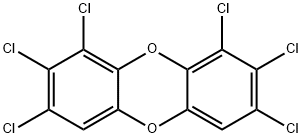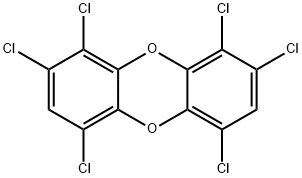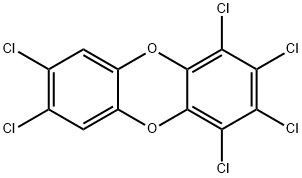DIBENZO-P-DIOXIN
- CAS NO.:262-12-4
- Empirical Formula: C12H8O2
- Molecular Weight: 184.19
- MDL number: MFCD00022282
- EINECS: 205-974-2
- SAFETY DATA SHEET (SDS)
- Update Date: 2025-07-04 15:02:18

What is DIBENZO-P-DIOXIN?
Chemical properties
white crystalline solid
The Uses of DIBENZO-P-DIOXIN
Dibenzo-?p-?dioxin is a standard used in environmental testing and research as well as in the studying of PCBs, PCDDs and PCDFs in food.
Definition
ChEBI: Oxanthrene is a heteranthrene, a mancude organic heterotricyclic parent, a polycyclic heteroarene, an oxacycle and a dibenzodioxine.
Synthesis Reference(s)
Synthetic Communications, 13, p. 335, 1983 DOI: 10.1080/00397918308066985
General Description
White crystals or crystalline solid.
Air & Water Reactions
Insoluble in water.
Reactivity Profile
DIBENZO-P-DIOXIN is an ether. Ethers may react violently with strong oxidizing agents. In other reactions, which typically involve the breaking of the carbon-oxygen bond, ethers are relatively inert.
Fire Hazard
Flash point data for DIBENZO-P-DIOXIN are not available. DIBENZO-P-DIOXIN is probably combustible.
Properties of DIBENZO-P-DIOXIN
| Melting point: | 120 °C |
| Boiling point: | 278.5°C |
| Density | 1.2430 |
| refractive index | 1.6250 (estimate) |
| storage temp. | Sealed in dry,Room Temperature |
| form | powder to crystal |
| color | White to Almost white |
| Water Solubility | 1.4mg/L(25 ºC) |
| Stability: | Stable. Combustible. Incompatible with strong oxidizing agents. |
| IARC | 3 (Vol. 69) 1997 |
| EPA Substance Registry System | Dibenzo-p-dioxin (262-12-4) |
Safety information for DIBENZO-P-DIOXIN
| Signal word | Warning |
| Pictogram(s) |
 Exclamation Mark Irritant GHS07  Environment GHS09 |
| GHS Hazard Statements |
H302:Acute toxicity,oral H411:Hazardous to the aquatic environment, long-term hazard |
| Precautionary Statement Codes |
P264:Wash hands thoroughly after handling. P264:Wash skin thouroughly after handling. P270:Do not eat, drink or smoke when using this product. P273:Avoid release to the environment. P391:Collect spillage. Hazardous to the aquatic environment P301+P312:IF SWALLOWED: call a POISON CENTER or doctor/physician IF you feel unwell. P501:Dispose of contents/container to..… |
Computed Descriptors for DIBENZO-P-DIOXIN
New Products
4,4-Difluoropiperidine hydrochloride tert-butyl 9-methoxy-3-azaspiro[5.5]undecane-3-carboxylate Indole Methyl Resin N-Isopropylurea N,N-Dicyclohexylcarbodiimide(DCC) MELDRUMS ACID 5-METHYLISOXAZOLE-4-CARBOXYLIC ACID Magnessium Bis glycinate Zinc ascorbate 1-bromo-2-butyne 2-acetamidophenol 9(10H)-anthracenone Erythrosin B, 4-Piperidinopiperidine 2-((4-morpholinophenylamino) (methylthio) methylene) malononitrile 2,4-dihydroxybenzaldehyde 3-(4-morpholinophenylamino)-5-amino-1H-pyrazole-4-carbonitrile Methyl 2-methylquinoline-6-carboxylate 2,6-dichloro-4-nitropyridine 4-Bromo-2-chlorobenzonitrile 2-(benzylamino)acetic acid hydrochloride 4-(tert-Butoxycarbonylamino)but- 2-ynoic acid 3,4-dihydro-2H-benzo[b][1,4]dioxepine 1-Phenyl-1-cycloprppanecarboxylicacidRelated products of tetrahydrofuran



![1,2,3,4-TETRAFLUORO-DIBENZO[1,4]DIOXINE](https://img.chemicalbook.in/StructureFile/ChemBookStructure3/GIF/CB6273062.gif)




You may like
-
![Dibenzo[b,e][1,4]dioxine CAS 262-12-4](https://img.chemicalbook.in//Content/image/CP5.jpg) Dibenzo[b,e][1,4]dioxine CAS 262-12-4View Details
Dibenzo[b,e][1,4]dioxine CAS 262-12-4View Details
262-12-4 -
 Dibenzo-p-dioxin 97% CAS 262-12-4View Details
Dibenzo-p-dioxin 97% CAS 262-12-4View Details
262-12-4 -
 Oxanthrene CAS 262-12-4View Details
Oxanthrene CAS 262-12-4View Details
262-12-4 -
 3-(4-amino-1-oxoisoindolin-2-yl)-1-methylpiperidine-2,6-dione 98%View Details
3-(4-amino-1-oxoisoindolin-2-yl)-1-methylpiperidine-2,6-dione 98%View Details -
 20677-73-0 (2,2-diethoxyethyl)methylamine 98%View Details
20677-73-0 (2,2-diethoxyethyl)methylamine 98%View Details
20677-73-0 -
 3-(4-(hydroxyamino)-1-oxoisoindolin-2-yl)piperidine-2,6-dione 98%View Details
3-(4-(hydroxyamino)-1-oxoisoindolin-2-yl)piperidine-2,6-dione 98%View Details -
 57381-49-4 2-bromo-4-chlorobenzonitrile 98%View Details
57381-49-4 2-bromo-4-chlorobenzonitrile 98%View Details
57381-49-4 -
 4,6-dichloropyrimidine-5-carbaldehyde 98%View Details
4,6-dichloropyrimidine-5-carbaldehyde 98%View Details
5305-40-8
Statement: All products displayed on this website are only used for non medical purposes such as industrial applications or scientific research, and cannot be used for clinical diagnosis or treatment of humans or animals. They are not medicinal or edible.
